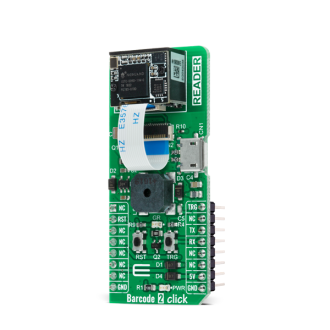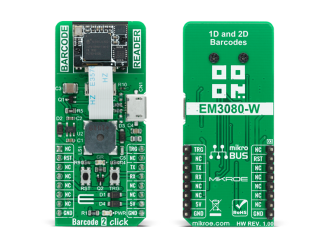
We strongly encourage users to use Package manager for sharing their code on Libstock website, because it boosts your efficiency and leaves the end user with no room for error. [more info]

Rating:
Author: MIKROE
Last Updated: 2020-09-24
Package Version: 1.0.0.0
mikroSDK Library: 1.0.0.0
Category: Miscellaneous
Downloaded: 3389 times
Not followed.
License: MIT license
Barcode 2 Click is an adapter add-on board that contains a computerized image recognition system that is compliant with a wide range of different 1D and 2D barcode protocols.
Do you want to subscribe in order to receive notifications regarding "Barcode 2 click" changes.
Do you want to unsubscribe in order to stop receiving notifications regarding "Barcode 2 click" changes.
Do you want to report abuse regarding "Barcode 2 click".


Library Description
The library covers all the necessary functions to control Barcode 2 Click board. A library performs the communication with the device via UART interface.
Key functions:
uint8_t barcode2_read_byte( ) - Read Single Byte.void barcode2_enable_scaning ( uint8_t en_state ) - Enable scaning function.void barcode2_enable_reset ( uint8_t en_state ) - Enable reset function.Examples description
The application is composed of three sections :
void application_task ( )
{
mikrobus_logWrite( "---------------------", _LOG_LINE );
mikrobus_logWrite( " Scan barcodes: ", _LOG_LINE );
barcode2_enable_scaning( BARCODE2_ENABLE );
Delay_ms( 2000 );
mikrobus_logWrite( "", _LOG_LINE );
mikrobus_logWrite( "---------------------", _LOG_LINE );
mikrobus_logWrite( " Scanning is off ", _LOG_LINE );
barcode2_enable_scaning( BARCODE2_DISABLE );
Delay_ms( 2000 );
}
Other mikroE Libraries used in the example:
Additional notes and informations
Depending on the development board you are using, you may need USB UART click, USB UART 2 click or RS232 click to connect to your PC, for development systems with no UART to USB interface available on the board. The terminal available in all MikroElektronika compilers, or any other terminal application of your choice, can be used to read the message.